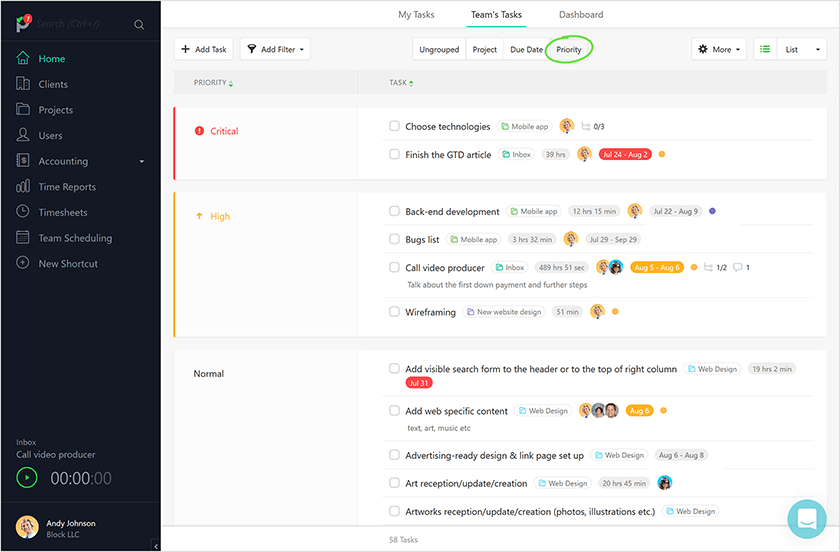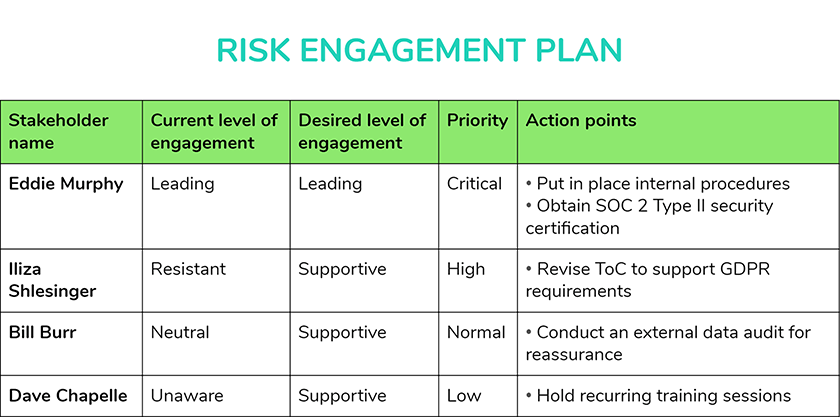
First Published: 15 June, 2022
Have you ever been so eager to manage a project, only to be stopped in your tracks by someone higher up the ladder?
That’s what happens when you lead with your heart instead of a project stakeholder management plan. One that can help you determine who the project stakeholders are – even if they’re not part of it – and how to engage with them before any conflicts of interest show up.
Without guidance though, the plan can become too complex and act against its purpose.
That’s why we’ve developed a simple one with only 4 phases (and templates to download) on how to win over people regardless of how new you are to project management or leadership in general. Let’s see what it’s all about.
As the name goes, project stakeholders are the ones with a direct stake in the project. The project sponsors, managers, team members (people inside your organization, who finance, oversee, and execute the project), followed by subcontractors and customers (people outside your organization).
The list is not complete though. People who are indirectly affected by the project outcomes—either in a positive or negative way—are also part of this group. Like the support team who needs to know about the new product launch to troubleshoot it in case of any errors.
However, it would be naive to believe that only these broad categories exist. In some cases, project stakeholders might be represented by a middleman (like with residential or construction projects) or not even introduced at the initial kick-off meeting.
To make sure you leave no one out, run the following stakeholder analysis:
As a rule of thumb, start with the project charter or business brief to learn more about the main decision-makers and their expectations. This might sound too obvious, but remember that they also respond to others in higher positions.
So think of all those in power to approve requirements, veto future changes, and even stop the project when their work or agenda gets slightly disrupted.
Subcontractors and suppliers, in general, are clearly stated in the agreements and contracts attached. The only remaining group of stakeholders you need to be aware of is those over which you have little to no control: the government regulators and your competition.
When done, put a name and role to each of them where possible. We’re not trying to create a fully-fledged stakeholder persona, but a more relatable picture of who to align our interests with.
Once all the project stakeholders have been identified, it’s time to determine the level of influence they have over the project. And since everyone has their own definition of success, there’s no choice but to rely on you and your team’s judgment to separate champions from detractors.
The Mendelow’s Matrix is the perfect tool for this, categorizing project stakeholders after the power and interest they hold:

Manage closely, Keep satisfied, Keep informed, and Monitor are the desired courses of action to engage with each stakeholder, which will be useful in the next phase of the stakeholder management plan. But for now, there’s still one last thing to do at this phase.
Assuming a silent stakeholder is a happy one is a sure way to lose support – especially with key stakeholders. You can’t afford this, so focus on how they feel about the project. The best way to find out is to ask them directly during a personal meeting.
Start with a series of questions like:
Laura Barnard, the founder of PMO Strategies, even suggests making it all about them. Hence ask:
How do they want the world to look different when the project is finished?
By framing the conversation in relation to this outcome, you’re one step closer to winning their support and being seen as a business enabler, rather than a “box checker that just moves people through a checklist of tasks”.
Don’t forget to document all the stakeholder concerns and leave the rest of the answers that revolve around communication for the next phase.
OUTCOME: The stakeholder analysis should end up in the following stakeholder register.

With the stakeholder register in place, you need to engage appropriately with stakeholders based on their level of influence.
Flooding them with all the project details in the hope that they’ll keep what they want and discard the rest is a common mistake. Not everyone is supposed to have access to certain data. Imagine the summer intern reading the next quarter’s forecasts, or the project sponsor analyzing the project timeline only to find out that it’s going to be delayed by two months.
To avoid this from happening, develop a communication plan that is visible and actionable enough to guarantee the much-needed buy-in from your stakeholders. One that identifies who should be informed about the project progress, by whom, in which format, and when. Let’s see what elements we’ve already got.
Even though stakeholders have been mapped out, an important aspect hides in plain sight: the fact that they can also communicate with each other. To determine the total number of potential communication channels, Shiv Shenoy from PM Exam Smartnotes advises using this formula:
Total communication channels = n*(n-1) / 2
So for 10 stakeholders, there’s going to be 10*9 / 2 = 45 potential communication channels. This shouldn’t discourage you but serve as a warning that the situation is serious even for smaller projects.
The second known element is the engagement action based on Mendelow’s Matrix, depicting how much attention you should give to each stakeholder category: Manage closely, Keep satisfied, Keep informed, and Monitor.
What’s still missing from the stakeholder communication plan are owners, communication channels, and frequency.
Owners bring an extra level of credibility and transparency to the entire communication plan, pointing out who is responsible to update each stakeholder. On most occasions, it’s going to be the project manager. But in some cases, they can delegate this duty to other team members, like the product manager when it comes to sharing the company vision and how the project supports it.
Not all communication channels are created equally. Informal written correspondence like email or Slack threads is great for documenting the overall project progress. But you wouldn’t resort to it if there’s an urgent issue to clarify with all key stakeholders.
Because of this, consider the following types of communication channels:

Email notification settings in Paymo
Internal policies, non-disclosure agreements, and location will also affect the way you communicate with your stakeholders, so choose the communication channels in relation to your own context.
NOTE: Some stakeholders may want reports, estimates, expenses, timesheets, and even invoices. There are great online tools to help you with estimating costs and creating invoices. Simple invoicing software is ideal for these kinds of reporting and when communicating with stakeholders.
Communicating with stakeholders as frequently as possible is bad advice. At best, it bores them down with useless details. At worst, it renders them unable to distinguish signal from noise.
What you can do instead is rely on Mendelow’s Matrix. Talk with key stakeholders on a daily basis to anticipate any possible concerns, brief executives only about the major project milestones, and send “cheerleaders” a weekly or bi-weekly digest to calm down their cravings for new updates.
The best way though is to actually ask them directly. You’ll find that some stakeholders prefer to be contacted at the end of the project, while others, despite their low stakes, need to be handheld at every possible step.
OUTCOME: The gathered elements should end up in the following communication plan.

* Engagement action: Manage closely/Keep satisfied/Keep informed/Monitor
Download the PDF template — Communication Plan.
Don’t expect to create it once and forget about it though. As Elizabeth Harrin of Girl’s Guide to Project Management notes:
Some people will feel they want to be more involved than the project organization structure requires. Others may receive communication and then not act on it, so be prepared to review and flex what you are doing so that you have a feedback loop that enables you to continually improve how you engage and communicate with people across the business to get a successful outcome at every stage.
This brings us to the next phase of how to monitor risky stakeholders.
“No man is an island.”
This is an old saying to remind us that no one is a product of their own efforts. The same can be said of projects, who depend on several project stakeholders and their support to come alive.
Yet not all of them are willing to let you have it your way just because you’re the project manager. They might smile and agree with you in the face, then point out unnecessary flaws or change project requirements at the next status meeting – the passive-aggressive sticklers. Or operate in silence and sabotage the project just because it represents a threat to their own agenda – the saboteurs.
Catching them mid-project does nothing but gather more enemies. So your best defense is to run a risk stakeholder analysis – preferably before the project starts – with the following elements:
Mendelow’s Matrix is a bit too broad to determine each stakeholder’s level of engagement – be they existing or new ones.
For this, Shiv Shenoy recommends classifying stakeholders into five engagement levels:
Then plot them on a matrix with C for the current level of engagement and D for the desired one.

Engagement Assessment Matrix
The current and desired level of engagement isn’t enough to tell you when to engage with a stakeholder.
To find this out, we turn to another tool used to identify stakeholders that have been overlooked on purpose because of its complexity: the salience model. On top of the power and interest (dubbed “legitimacy”) dimensions, it also includes a third one: urgency.
The urgency here refers to the degree to which a stakeholder expects his concerns to be addressed. Are they short-sighted and focused on gaining quick wins, or more on fulfilling the company’s long-term vision?
How you set the priority criteria is up to you. Although I’d customize it to match the priority levels in your work management software, so you know which tasks to start working on before others.

Priority grouping in Paymo
NOTE: Check out these best project managing tools for organizing your tasks. Or even better, these Gantt chart timeline software to compare daily task durations and their sequence order.
Have you ever watched the famous TV series Billions? If not, then picture a series of billionaires and prosecutors who do favors for other “friends” – for lack of a better word – in order to advance their goals.
As machiavellian as it may sound, managing stakeholders is more or less the same: you need to find out what makes them tick. Some might sacrifice quality at the expense of cost, while others may only trust a selected group of insiders instead of your lead. Then play those interests to your advantage.
You’re already aware of their true motivations and concerns from the previous phases, so what’s left is to list out the corresponding actions that will secure their commitment. The only difference is that you openly outline these “favors” to the whole project team, as opposed to making them behind closed doors.
OUTCOME: The risk analysis performed so far should end up in a risk engagement plan.

How do you know if the engagement action points from before actually worked out as planned?
The best way is to create a system that feeds itself with suggestions from each stakeholder, acting as an improvement log to be referenced for future best practices.
In this case, templates are of no use, so we’ll give a set of dos and don’ts instead.
The feedback loop concludes the stakeholder management plan example, which means you can go ahead and apply it in the real world.
A few words of advice. Don’t expect it to do miracles and guarantee project results. After all, projects, like people, can change in a matter of seconds. But use it as a way to know who the key project stakeholders are, how and when to engage with them, as well as whom to worry about at any point in time.
So climb the ladder of authority with confidence knowing that you’re fully equipped to protect your project from any stakeholder that might second guess it or kill it without even a trace of remorse 🙂

Contact us if you have any suggestions on resources you would like to see more of, or if you have something you think would benefit our members.
Get in TouchSign up to receive updates on events, training and more from the MA.
